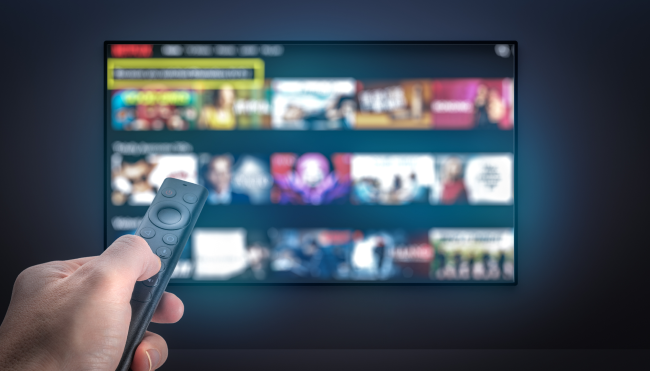- Why Amagi
-
Solutions
Contact UsBusinessWho We Serve
- Offerings
- AI
-
Resources
Contact UsINDUSTRY REPORTSAmagi FAST Report #15: The Power of Live Programming: A Catalyst for Streaming SuccessAugust 21, 2025Read More
-
Company
Contact UsNewsroomAmagi launches AI-powered Smart Scheduler to improve content programmingApril 3, 2025Read More
Blog
Transforming live broadcasting through cloud technology, FAST, and single live events
By Kalaivani Sivasankaran - July 4, 2024
Producing live events used to demand substantial resources, including planning, time, energy, hardware, and expenses. Historically, scaling up for live events could be quite costly due to broadcasters’ decades-long reliance on traditional broadcast methods and on-premises infrastructure. And once these on-premises systems were initiated, halting their usage was challenging, thereby leading to higher associated expenditures. Fortunately, this resource-intensive process has become more flexible and cost-effective with the advent of cloud technology, which has largely minimized truck rolls, reduced operational costs, and optimized resource usage.
Today, with broadcasters offering over-the-top (OTT) options alongside cable, adopting a unified workflow is far more essential to reach a broader audience. Fortunately, cloud technology has evolved to the point where delivering single live events (SLEs) is becoming increasingly feasible while demonstrating immediate ROI. Meanwhile, viewers and platforms demand a cable-like viewing experience from their streaming services, complete with robust graphics, superior audio quality, personalization options, precise ad targeting, advanced analytics, and actionable insights. Legacy hardware-centric operations are no longer sufficient to handle all these expectations. This renders cloud technology crucial not only for distribution, delivery, and asset management but also for content quality, monetization, and viewer engagement.
Why Broadcasters Embrace Cloud Migration: Efficiency, Security, and Scalability
Today, the decision to transition to the cloud has been generally straightforward for broadcasters, given the numerous benefits that the cloud offers compared to on-premises solutions.
For one, automation of playout, distribution, and monetization in the cloud streamlines resource management, thereby optimizing costs and improving ROI. While the management and allocation of resources for both live and non-live applications may require direct collaboration between the broadcaster and the cloud provider, this process can often be manual and arduous. SaaS providers offer a suite of specialized, purpose-built processing tools that automate the scaling of resources up or down based on programming schedules. These tools are particularly beneficial for SLE scenarios, as they ensure efficient provisioning of resources according to the event’s start and end times. This approach helps broadcasters and cloud providers minimize wastage and optimize resource use.
Another benefit is security and reliability. Noteworthy cloud SaaS providers will not only make their solutions available for any cloud platform of the users’ choosing but also leverage the built-in security and compliance protocols that these platforms have for users’ own cloud accounts. While SaaS providers don’t always maintain their own cloud infrastructure, partnering with the likes of Amazon and Google enables them to utilize these platforms on behalf of their end users. In doing so, SaaS providers can leverage these leading cloud platforms to protect content with robust security and compliance measures, thereby assuring end users that their content remains secure.
Above all, the primary advantage of the cloud lies in its scalability and futureproofing, both of which allow SaaS providers to align their tools with the needs of various live events and evolving use cases. Having constant access to the latest features and functionality enables broadcasters to stay ahead of the curve and reduces the need for extensive self-management. In essence, broadcasters can focus on their core activities without the burden of managing infrastructure hardware, dealing with hardware failures, or disruptive updates that can erase progress.
How Cloud Technology Synergizes With CTV, FAST, and Pop-up Channels

FAST wouldn’t have achieved its popularity without a combination of cloud technology advancements and the increasing prevalence of CTV. By virtue of being connected over the internet, CTVs, OTT platforms, and the cloud are open to collecting richer viewer metrics, such as viewing patterns by region, ad impressions, and more. To benefit from this data, broadcasters will need analytics and server-side ad insertion tools for more strategic content personalization and ad targeting, as well as pre-determined KPIs for effective data capturing, measurement, and analysis. This curated, personalized experience entices viewers to see FAST as a more accessible and dynamic alternative to traditional broadcast, cable, and on-demand streaming, hence its profound growth.
Likewise, CTVs offer prime real estate for monetization and interaction opportunities on FAST channels, particularly on the bottom banner. This placement makes it easy for users to discover channels — all without requiring a subscription — and for platforms to set them up. In fact, the bottom banner appears to be gaining popularity, likely due in part to the younger generation’s preference for shorter ad experiences and the increase in mobile/OTT content viewership in regions where cable is too expensive. Unifying all these CTV strategies in the cloud provides a significant advantage in terms of automation and personalization.
This combination of the cloud and CTV-led FAST has made the prospect of pop-up events far more feasible, profitable, and cost-effective. With the adoption of cloud technology for SLEs, the need for up-front investment and hardware infrastructure lock-in has been significantly reduced. Instead, broadcasters can readily provision cloud infrastructure for the duration of an event and terminate it once the event concludes. Additionally, thanks to the ad-support model, viewers can tune into live events freely and enjoy unobtrusive ads, thereby enhancing the viewing experience while driving better monetization.
This flexibility is highly advantageous for rights owners and holders of all live broadcasting, including sports, music, esports, news, political events, and other special occasions. Cloud technology enables broadcasters to run redundant live sources for parallel events, effectively hosting multiple live streams synchronously with the ability to scale up. This scalability offers broadcasters a significant advantage, as they can quickly multiply from a few events to a larger number when necessary. As a result, broadcasters can extend their inventory beyond premium rights ownership, offer a broader range of content, expand distribution through D2C applications, broaden viewership, and increase advertising revenues.
In essence, the cloud’s ability to drive pop-up channels for SLEs enables broadcasters to become more efficient with their content offerings. They no longer need to invest significantly in costly live production and playout systems only to justify these expenses with prolonged usage of the systems. Instead, they can rise above the limits these systems imposed on content rights, scaling up and down as needed and thereby maximizing both reach and revenue. And with the success of these pop-up channels, viewers may consider tuning into 24/7 curated channels with interactive programming, where broadcasters can reach even deeper into their target audiences and provide advertisers with even more opportunities for impressions.
How Cloud-Powered Curated Channels Can Enhance Audience Reach and Engagement
The potential for growth within live broadcast, especially in the fast-paced digital arena, is truly exciting. What makes it so appealing is not only its growth potential but also its global reach. The sky’s the limit when it comes to the opportunities that lie ahead, and the key to unlocking these opportunities is the ability to reach a massive audience while also offering curated channels for live events. These channels would provide a highly focused means of connecting with intended audiences, making them one of the most significant opportunities in terms of growth and precision in targeting.
Broadcasters can discover immense creative possibilities through the unique approach of creating curated channels for fans and ensuring the right audience is engaged throughout live events. While a pickleball channel, for instance, may not currently represent the largest advertising opportunity, it has massive potential to target and reach specific yet underrepresented audience personas directly. A cloud-enabled pop-up channel is a great way to test the waters — all without costly hardware investments — and see how much of an impact this niche content will make. Moreover, CTV-led FAST can do more than just cut to an ad break; it can also incorporate creative graphics — such as picture-in-picture viewing, overlays, and more — to promote brands seamlessly. As a result, broadcasters will not only see an immediate ROI but also gain a following for their other properties, thereby ensuring greater reach and monetization in the future.
The industry-wide transition towards cloud-enabled FAST will continue to gain momentum, especially in the realm of live broadcasting. FAST is already playing a significant role in making content accessible, seamlessly integrating advertising, and simplifying the process of discovery and streaming. But to achieve even greater reach, curating niche content for SLEs will play a pivotal role and ensure that it finds a home and a global audience. Thanks to the cloud’s simplification of cost and logistics for coverage, utilization and automation of processing tools, intelligent resource management, and support for simultaneous live streams and events, all of this is possible.
This article was originally published in SVG News.
Related Blogs
Get Started
Increase revenue and reach with our Broadcast & Streaming solutions.
Cloud modernization. Streaming unification. Monetization. Marketplace.
 German
German French
French Spanish
Spanish Korean
Korean Japanese
Japanese Portuguese
Portuguese


